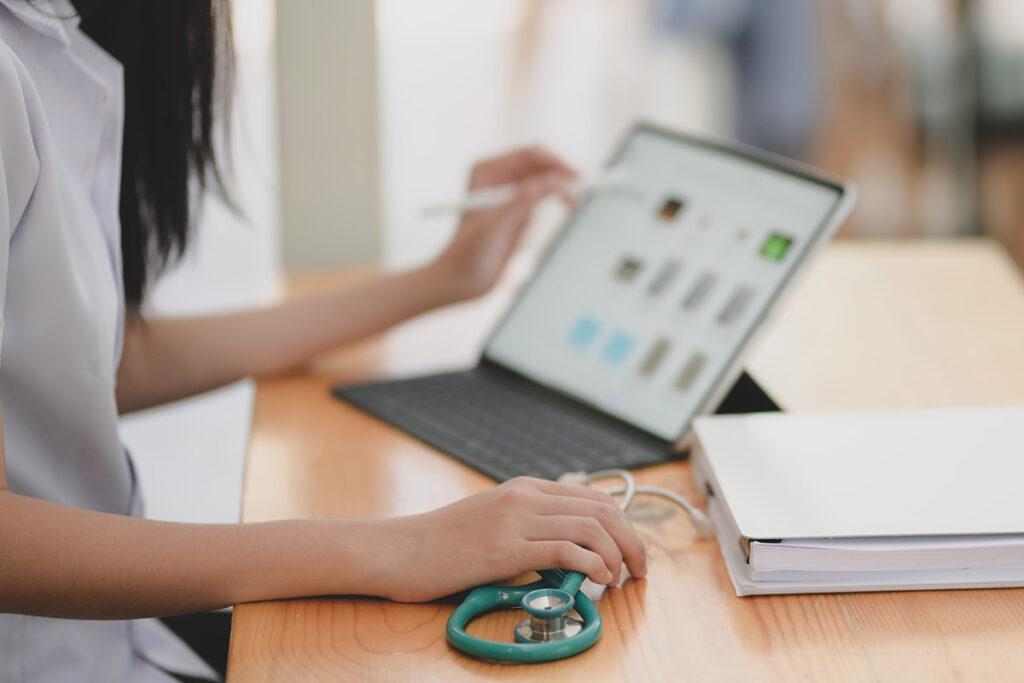It is not a novelty that healthcare is one of the world’s largest and fastest-growing industries, using around 10% of the GDP in developed economies. In the US only, for the first time in history, healthcare surpassed manufacturing and retail in 2018 to become the largest source of jobs in the country. Similarly, NHS, UK’s National Health Service, is the biggest employer in the country and the fifth-largest in the world.
The past decade has registered a revolution in technology advancements and patient-centric medicine. This trend continues and we see successful health systems investing in decisive areas such as data insights, home healthcare initiatives or personalization, and healthcare companies emerging and advancing as digital businesses. However, challenges will continue to hinder but also hasten transformation in the healthcare ecosystem. Poor data integrity and collaboration, misaligned workflows, privacy, and security issues are the most important concerns that are top of mind for industry players. Technologies such as cloud computing, 5G, Artificial Intelligence (AI), Natural Language Processing (NLP), Machine Learning (ML), automation, and the Internet of Things (IoT) can be effectively leveraged to help streamline healthcare delivery and align it with changing consumer expectations. People have come to expect healthcare services on their own terms, with technology being a decisive enabler.
In this ecosystem that is susceptible to the constant disruption coming from multiple factors, it is necessary to be aware of the latest trends and developments, and understand to what extent the business decisions of tomorrow will be impacted by today’s challenges or opportunities. With this in mind, we have compiled a list of the most important trends to watch this year and beyond.
The global healthcare market: the potential for growth
According to “Healthcare Global Market Opportunities and Strategies to 2022” report by Research and Markets, the global healthcare market reached a value of approximately USD 8,452 billion in 2018, having grown at a CAGR of 7.3% since 2014; the industry is expected to thrive further, at a CAGR of 8.9% to USD 11,908.9 billion by 2022. In 2018, healthcare services was the largest segment of the healthcare market, accounting for 79.4%, followed by pharmaceutical drugs and medical equipment. North America was the largest market for healthcare (41.9% of the global market), followed by Asia-Pacific, and Western Europe.

Changing consumer expectations and attitude towards healthcare services
Healthcare is constantly moving towards patient-centered care and non-traditional care models. Thanks to new technologies, individuals gain autonomy and become active participants in managing their healthcare plans. Above all, a great deal of interest is given to preventive healthcare, a promising area in terms of the level of innovation that is expected to be leveraged.
Accenture’s 2019 Digital Health Consumer Survey on US consumers has uncovered noteworthy discrepancies of satisfaction levels between different types of consumers. According to the survey, millennials are two to three times more likely than baby boomers to be dissatisfied with the convenience of appointment times, the location/channel of care, and the effectiveness of healthcare services. According to the survey, 55% of Gen Z, 67% of millennials, and 84% of baby boomers declare they have a primary care physician, while millennials are the most open to non-traditional healthcare methods such as medical services from retail clinics (41%) and virtual care (39%).
When it comes to the use of digital healthcare services, 51% of all respondents stated that they use a wearable or mobile app to manage their lifestyle and healthcare conditions; 53% use virtual nurses. The study shows that younger generations are more likely to choose medical providers with strong digital capabilities, such as those who provide mobile or online access to test results, electronic prescription refills, and booking, changing or canceling appointments online. As Kaveh Safavi, Head of Accenture’s Global Health Practice concludes, “providers and payers who stay one step ahead of the shifts and deliver what patients are looking for will be the ones to earn loyalty, navigate disruption and be strongly positioned as the future unfolds.”
The impact of disruptive technologies
Accenture’s Disruptability Index, which analyzes the level of disruption across 20 industries, places healthcare among the most vulnerable industries to future disruption, being the most susceptible to scale new technologies. The next set of emerging technologies that are expected to bring new waves of disruption are considered to be Distributed Ledger Technology (DLT), Artificial Intelligence (AI), Extended Reality (XR), Machine Learning (ML) and Automation.

There are multiple areas in which these technologies are expected to bring benefits, patient engagement being perhaps the prevalent one, with use cases such as remote diagnosis, remote patient monitoring, telemedicine, and many others. However, one of the challenges in exploiting the benefits of these technologies to the maximum is consumer trust. A study conducted in the US in 2018 indicates that US consumers are not comfortable with sharing their health data with tech companies. Similarly, research conducted in the UK shows that consumers are skeptical about digital health products, while a study conducted in Switzerland indicates that digital health is dependent on trust in order to succeed. Despite this, there are numerous initiatives that use people’s health-related information to predict illnesses, diseases, or medical conditions. According to Stony Brook University and Penn Medicine, Facebook posts can be used to predict 21 conditions and diseases like hypertension, diabetes, depression, and anxiety, due to some connections that can be identified between diseases and language patterns.
5G
To succeed in the healthcare industry and meet consumer’s expectations, hospitals and healthcare systems find it increasingly necessary to tackle supply chain and logistical problems. An outstanding percent of healthcare executives (82%) agree that 5G will revolutionize their industry by offering new ways to provide products and services (drone delivery, driverless vehicles, faster video transmission). 5G technology comes with instantaneous web connections, which will streamline the adoption of remote healthcare services, making it possible for patients to be treated through their computer or mobile devices.
Distributed Ledger Technology
As Digital Health Tech Vision report by Accenture shows, DLT can bring many benefits, especially when it comes to creating a trusted set of data so that people can act on the information without having to verify its authenticity. DLT applicability is high and can be leveraged in areas such as qualifying individuals for different types of services or identifying patient payment obligations and credentialing providers.
Extended Reality
Extended Reality is already showing a high number of use cases, with 38% of healthcare organizations having adopted XR across one or more business units. This technology has a decisive impact on the relationship between humans and technology in healthcare units. It allows machines to operate cognitively and it helps people interact naturally with technology.
Artificial Intelligence
Currently, the AI technology is used to acquire, collect, and organize information on patients’ history, as well as for imaging diagnosis due to the fact that it facilitates decision-making and improves different types of processes prior to diagnosis. AI has perhaps the greatest number of emerging use cases in healthcare, with 41% of healthcare executives ranking AI number one among the technologies with the greatest impact on healthcare organizations over the following years.
Machine Learning and Automation
Automating mundane and repeatable tasks is no longer a novelty in many industries but the process keeps its top priority in the healthcare space due to the fact that this industry is currently employing the highest number of people in many developed countries and certain activities can be easily automated. The possibilities to scale the usage even further are numerous, but some of the most important ones are centered around improving access to relevant insights, gaining operational insights from smart analytics, streamlining the emergency room operations, ordering, or smarter billing.
Looking beyond the pandemic
Whether we are discussing trends that shape consumer expectations or the impact of the latest technologies in healthcare, in 2020 it is obvious that the new normal brought by COVID-19 pandemic is accelerating certain changes while hindering others.
Health systems all over the world have started prioritizing tools and services that enable care to be delivered remotely, with the aim to keep patients and healthcare professionals away from potential infection. The interest in telehealth services has exploded, in a bid to keep up with the new patient-care standards and generate new revenue streams as certain non-urgent health-related practices have been put on hold.

As COVID-19 has brought to light the need for larger structural changes in a space where interoperability within and between sectors is limited, several tech and retail giants have proven to be aware of the situation and launched initiatives in the realm of telemedicine to fight the spread of the virus. In April, Walgreens has announced the expansion of its telehealth program to include a COVID-19 risk assessment. Walgreens Find Care helps patients search for telehealth providers and for locations where they can connect with a doctor or nurse practitioner to receive care for common health and wellness needs. In addition, using the Walgreens app, patients can fill their prescriptions at Walgreens and choose their delivery option, which includes in-store pickup, drive-thru, or home delivery.
Similarly, Apple and Google released the first versions of their Covid-19 contact-tracing tools to public health organizations in April, with the aim to help companies build applications ahead of the system’s launch in mid-May. The toolset is a combination of software updates for iOS and Android and software development kits to help developers build and test their apps. The first phase of the system will let healthcare companies build apps that allow people who had tested positive for Covid-19 to input their diagnosis. Using Bluetooth technology, the system will notify the people with whom the person has been in contact, warning them of possible exposure. Similarly, the European Commission published an EU toolbox, accompanied by guidance on the protection of personal data, for the use of mobile apps for contact tracing and warning. This toolbox sets the scene for the development of contact-tracing tools that align with data protection regulations within the European space.
To what extent 2020 healthcare trends with an impact on practices and innovation will be accelerated by the pandemic remains to be seen. Nevertheless, to stay strong and thrive in this ever-changing ecosystem, collaboration is key. Here, at Maxcode, we are open to discuss your innovation journey towards providing smarter and relevant solutions to your partners. Contact us to learn more.




